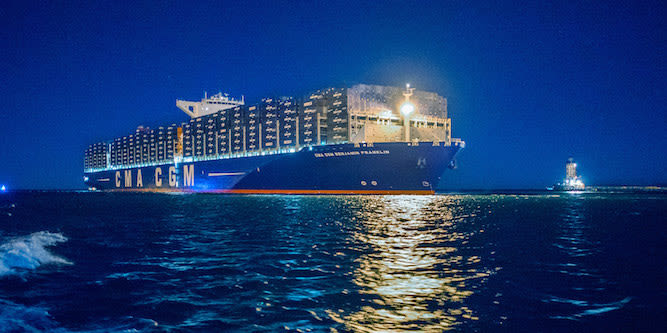
January 13, 2016
Watch: Drone Video of Largest Ship to Visit U.S. Entering San Francisco Bay
Watch: Drone Video of Largest Ship to Visit U.S. Entering San Francisco Bay
January 13, 2016
_(Image of Port from Los Angeles, via CMA CGM) _
The CMA CGM Benjamin Franklin is the largest ship ever to sail to the United States. Flexport was so excited about her arrival in the Bay Area that we partnered with Dronebase to shoot an aerial video of her visit. Take a look at the short piece we put together on the Benjamin Franklin’s entrance into the San Francisco Bay and her docking at the Port of Oakland. You’ll see that she only just cleared the Golden Gate Bridge.
Embedded content: https://www.youtube.com/watch?v=Y9jVPoI4kyk
Here’s a bit more on how to appreciate her size.
First, her length: At 1,300 feet, she’s longer than Empire State Building is tall (the Empire State Building comes in at just over 1,250 feet). Her hull is wider than a football field. She’s longer than the world’s largest warship, the Nimitz-class USS George H.W. Bush.

(Image via CMA CGM)
Next, her capacity: She’s able to carry 18,000 TEUs (twenty-foot equivalent units, the standard unit of measurement of container capacity). All her containers placed in a straight line would equal the distance between San Francisco and Sacramento.
Her power: The engine thrust she produces is equivalent to one generated by ten Airbus A380s—the largest passenger aircrafts operating today. Here’s another way to put it: The power plant produces enough electricity to fuel 16,000 households.
Construction: She was made by a Chinese company, the Shanghai Waigaoqiao Shipbuilding Co. Her hull features a bulbous bow with double-hull protection. Her total cost? $151 million USD. That’s less than the cost of a Boeing 787 Dreamliner. London is her port of registry, and she flies a British flag.
Energy-efficiency: She’s one of the greenest vessels sailing today. She’s met 2025 emissions standards, and her design decreases CO2 emissions by 10% relative to older cargo ships.
Her crew: A lean 27 people staff her operations. They’re able to entertain themselves in the ship’s swimming pool when they have time.
The itinerary: Her sailing to the Port of L.A./Long Beach and the Port of Oakland was her maiden voyage. She departed for China after unloading at Oakland. She’ll make a second voyage to the West Coast in February to test whether local ports can handle a ship of her size. Her current route is between the ports of Southampton in Britain and Tianjin in China.
The logistics: Both ports devoted major resources to make her voyage a success. Up to 1,500 longshore workers were deployed in L.A. alone, and there she brought out the largest number of cranes deployed simultaneously on a single vessel. L.A. is developing more terminals that can handle megaships. Oakland has been investing millions, and preparing too by dredging berths and and raising the height of its cranes.
The parent company, CMA CGM: The Compagnie Maritime d’Affrètement Compagnie Générale Maritime is based in Marseilles, with North American headquarters in Norfolk, Virginia. CMA is the world’s third largest ocean carrier by carrying capacity, up to 1.8 million TEU, which is about 9% of the container space market.
Right now all the world’s megaships sail between Europe and Asia. The Benjamin Franklin will be visiting the West Coast again. If ports are able to handle her voyage and volume, we can expect to see many more megaships sailing to America soon, bringing goods and commerce to the region.
Read this next >> A Guide to the Largest Ocean Carriers in the World
About the Author
January 13, 2016




